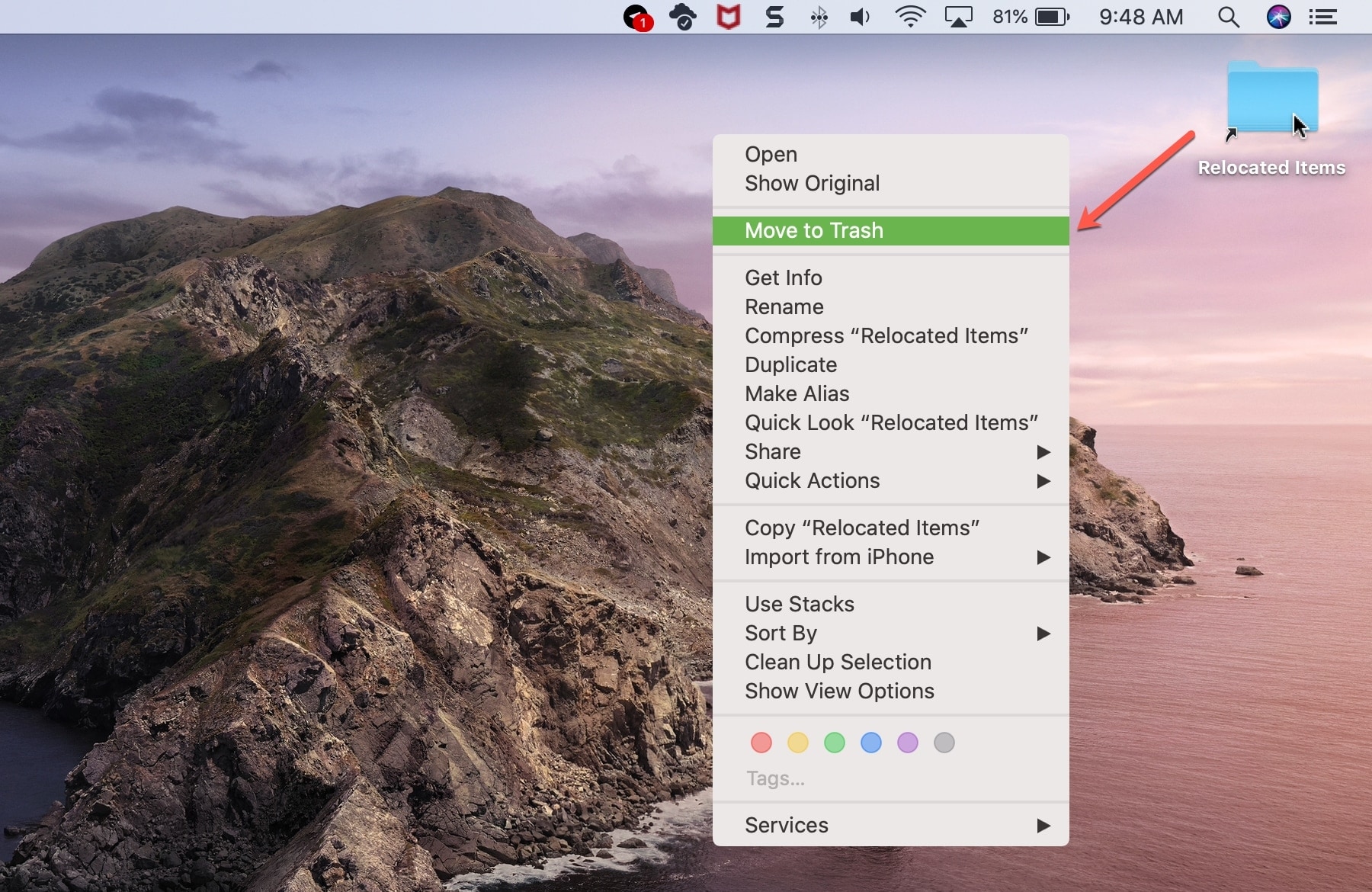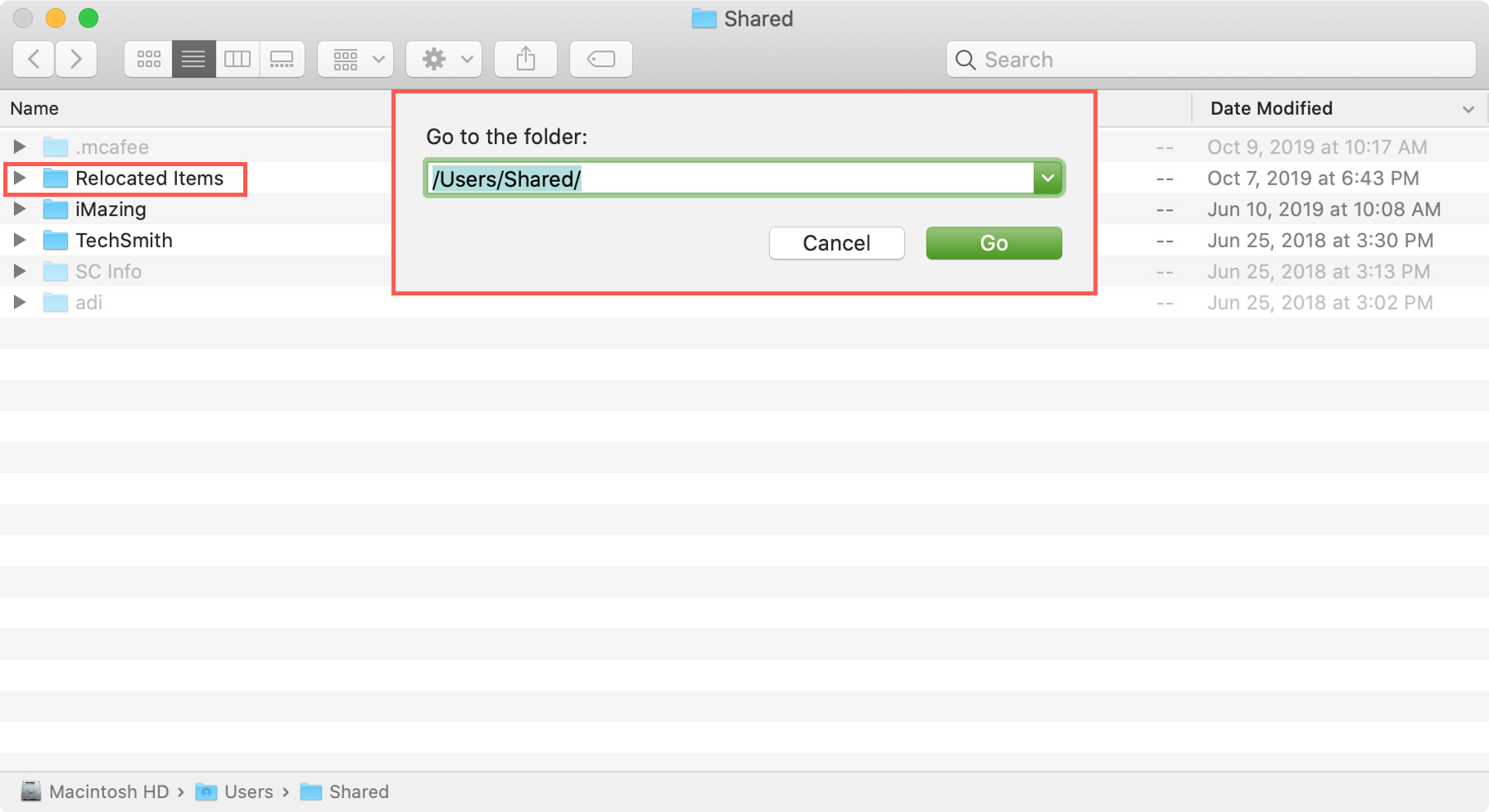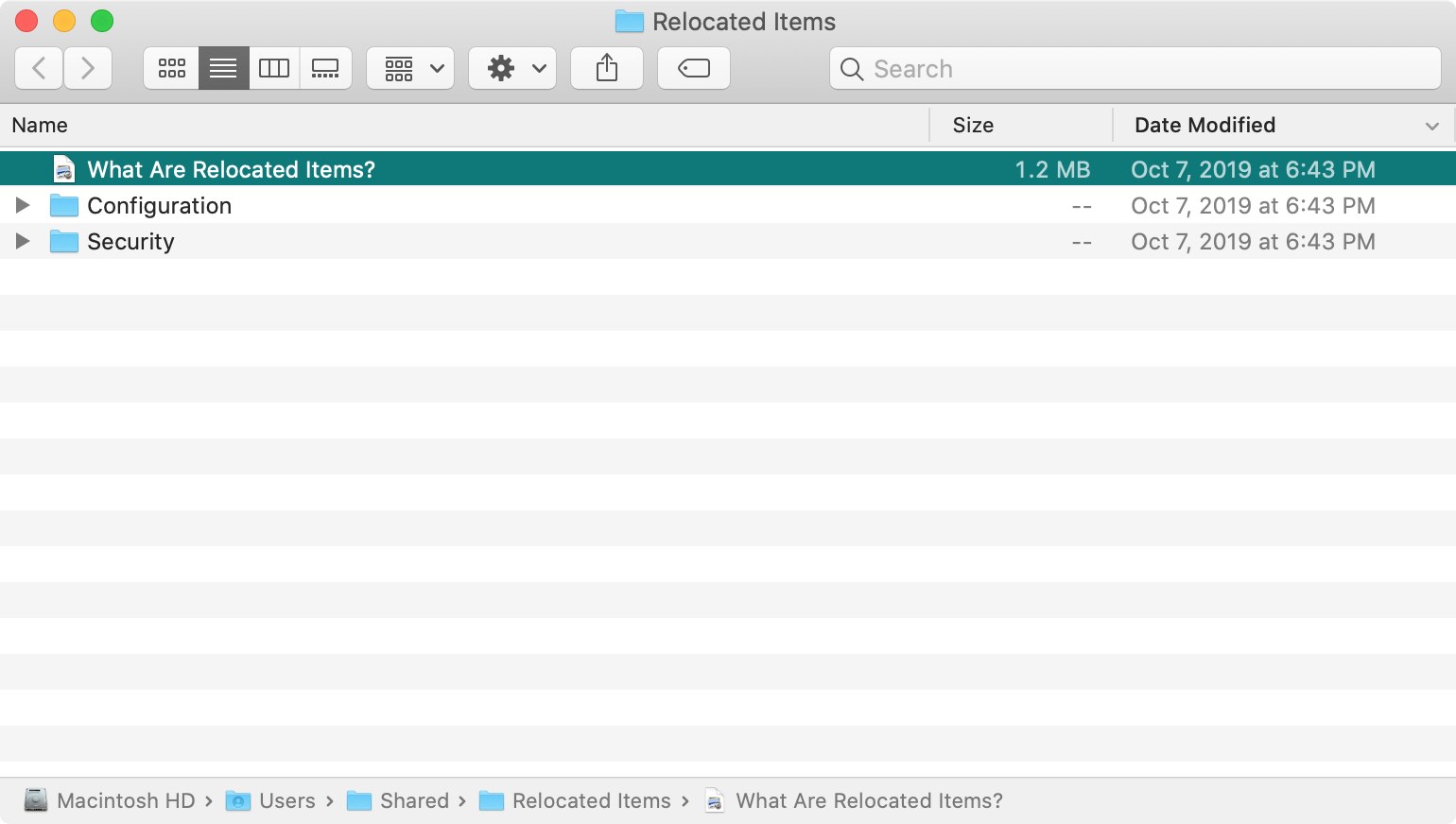Understanding Relocated Items Catalina: What's That Folder On Your Mac?
So, you've just updated your Mac to macOS Catalina, and you're seeing a new folder on your desktop called "Relocated Items." It's a bit of a mystery, isn't it? This folder can feel a little surprising, appearing after what you thought would be a smooth upgrade. Many Mac users, just like you, have found themselves scratching their heads, wondering what these items are and why they've suddenly appeared.
Well, these relocated items are, in a way, older bits of information and data from earlier macOS setups. Apple, you see, wasn't quite sure what to do with them once you made the jump to Catalina. Catalina, in fact, was the very first macOS release to fully embrace the newer Apple File System, or APFS, which is, you know, designed for the faster flash storage found in many newer Macs. This change in how your Mac organizes its files is a big part of why this folder shows up, actually.
When your Mac went through that upgrade process, it tried to move all your files to their proper new spots. If some files just couldn't quite make it to their designated new homes, they were, in some respects, gently placed into this "Relocated Items" folder. This article will help you understand what this folder is all about, why it pops up, and what you can actually do with it, which is pretty useful, you know, for peace of mind.
Table of Contents
- What Are Relocated Items Catalina?
- Why Did This Folder Appear on My Desktop?
- Finding Your Relocated Items Catalina Folder
- Do You Really Need These Relocated Items?
- Managing and Removing Relocated Items Catalina
- A Closer Look at the Contents
- What Happens with Future Updates?
- Common Questions About Relocated Items Catalina
- Frequently Asked Questions (FAQs)
What Are Relocated Items Catalina?
When you hear about "relocated items," it's about files and data that were part of your Mac's older operating system setups. These are things Apple, frankly, wasn't quite sure where to put after you updated to Catalina. It's a pretty common experience for users who upgraded to macOS Catalina, or even later versions like Big Sur, from an older macOS. You might just see this folder pop up on your desktop, and that's, you know, what we're talking about.
This folder is supposed to hold things that, well, "couldn't be moved to their new locations" on your system and data volumes. So, it's not a sign of trouble, really. It's just your Mac tidying up in a way, making sure nothing gets lost even if it doesn't fit perfectly into the new system structure. This process, you know, is a direct result of some big changes under the hood of your Mac.
The Big Change with APFS
Catalina, you see, was a pretty big deal because it was the first macOS version to fully adopt the Apple File System, or APFS. This file system is, actually, quite new and it's built specifically for the speedy flash storage that's in most modern Macs. So, when your Mac switched to APFS, it had to rethink how it organizes and stores everything. This change, in some respects, is a fundamental shift in how your computer works with its own files.
Older macOS versions used a different file system, and APFS has its own rules about where certain files should live. This means that some files that were perfectly fine in their old spots might not be allowed in those same places under the new APFS structure. It's a bit like moving into a new house with a different layout; some furniture just won't fit where it used to, you know? That's where the relocated items come in.
Why Files Get Moved
Files get moved to this special folder when macOS Catalina figures out they're outside the designated system directories. It's an automatic process, so you don't have to worry about doing anything yourself to cause it. For example, if you had files or folders saved right at the top level of your hard drive, which isn't allowed in Catalina, those would be candidates for relocation. This is, you know, Apple's way of keeping the system areas clean and secure.
The system is, in a way, trying to improve computer performance by moving from saving things directly on the main hard drive folder to more structured locations. If any of your files couldn’t be moved to their new spots during the upgrade, they're gently placed in this relocated items folder. It's a safety measure, frankly, to prevent accidental data loss during a major system overhaul. So, no need to panic if you see it; it's just your Mac being careful.
Why Did This Folder Appear on My Desktop?
Whenever you updated to Catalina, you likely soon saw that folder on your desktop. This happens because, as we discussed, the system needed to make some big changes to how it stores files, thanks to the new APFS. So, it's not a bug or an error; it's a planned part of the upgrade. You might have even, you know, already deleted the desktop shortcut for it, thinking you were getting rid of it.
The appearance of this folder is Apple's way of telling you, "Hey, we moved some stuff, and here it is." They don't just silently delete things or hide them where you'd never find them. Instead, they put them in a visible spot, along with an explanation. This transparency is, in some respects, quite helpful, letting you know exactly what happened during the upgrade process.
The Upgrade Process Explained
When you upgraded your macOS, say from High Sierra to Catalina, your system went through a pretty big conversion. This conversion involved changing the underlying file system and reorganizing how your operating system and your personal data are stored. The relocated items folder, you see, should contain all those "waifs and strays" found during this volume conversion. It's a bit like a temporary holding area for files that didn't quite fit the new structure.
This process is, actually, designed to be as smooth as possible, but with such a fundamental change, some files just can't be automatically integrated. So, instead of causing problems or losing data, your Mac creates this folder. It's a pretty smart way to handle things, giving you control over those older files. This is, you know, a common experience for many users who've made the leap to Catalina or Big Sur.
What Happens During the Update
During the update to macOS Catalina, your Mac checks for files or folders that are installed by applications but are outside the designated system directories. When it finds them, it automatically relocates them. This is why you might find a new folder on your desktop called “Relocated Items” if you updated to macOS Big Sur 11 or macOS 10.15 Catalina or later from an older version of macOS. It's a system function, in fact, that ensures system integrity.
There's nothing wrong with your computer, you know, if you see this folder. It's a normal part of the upgrade. This relocated items folder is supposed to contain those which “couldn’t be moved to their new locations” on the system and data volumes, and with them is a PDF document. This document, in some respects, is your guide to understanding what's going on, which is quite useful.
Finding Your Relocated Items Catalina Folder
You might have seen a shortcut to the "Relocated Items" folder right on your desktop after the upgrade. This shortcut is there to make it easy for you to find the folder. However, the actual folder isn't sitting directly on your desktop; it's tucked away in a specific spot within your Mac's file structure. This is, you know, pretty typical for system-generated folders.
Even if you've already deleted the desktop shortcut, the items themselves are still on your Mac. You haven't, in fact, gotten rid of the items by deleting the shortcut. So, if you're looking for the actual contents, you'll need to know where to go. It's a bit like throwing away the map but still needing to find the treasure, you know?
The Desktop Shortcut
After updating to macOS Catalina, you may be surprised to discover a shortcut on your Mac's desktop to a relocated items folder that wasn't there previously. This shortcut is just a pointer, really, to the actual location of the folder. It's Apple's way of making sure you're aware of these files and can easily access them if you need to. Every time an update comes out for Catalina, you might, in fact, get a relocated items alias on the desktop again.
This shortcut is temporary, in a way. You can delete it from your desktop without affecting the actual files. It's just a convenience, you know. But if you want to access the files, you'll need to go to the real folder. This is, frankly, a common point of confusion for many users, thinking that deleting the shortcut deletes the files themselves.
The Actual Location: /Users/Shared
The actual relocated items folder is located in the shared folder within the users folder. So, you'll find it at /Users/Shared/Relocated Items. This is a system-level location, which is why it's not just floating around somewhere random. It's placed there so that it's accessible but also somewhat out of the way of your everyday files. This location is, you know, pretty standard for shared resources on a Mac.
To get there, you can open Finder, click on "Go" in the menu bar, then "Go to Folder," and type /Users/Shared. Inside that folder, you should see "Relocated Items." This is where the actual files are stored, so, you know, if you're looking to recover something, this is the place to start. It's pretty straightforward once you know where to look, actually.
The Important PDF Document
Inside this relocated items folder, you'll find a PDF document. This document is pretty important, actually, because it explains what these items are. It's Apple's official explanation for why the folder appeared and what it contains. So, if you're feeling confused, reading this PDF is a really good first step. It's designed to clear up any questions you might have, you know, about the folder's purpose.
This folder also includes a PDF that, in fact, helps you understand the situation. The information in the PDF is meant to guide you, but sometimes, frankly, it makes no sense to some users because it can be a bit technical. It's either circular logic or, in some cases, there actually were no items that needed relocating, just the PDF itself. But it's always worth a look, you know, to get the official word.
Do You Really Need These Relocated Items?
This is a question many Mac users ask: "What is the relocated items folder on macOS Catalina and do you need it?" The simple answer is, it depends on what's inside. The folder houses older files and data that macOS Catalina can't find a use for in its new system structure. So, it's not necessarily vital system files, but rather things that were perhaps in non-standard locations before the upgrade. You'll want to check, actually, what's in there before making any decisions.
Find out whether you need it on your Mac or not by checking the contents. This detailed article will explore what the relocated items folder is, its significance in the context of macOS Catalina, and how users can navigate, manage, and make sense of this. So, it's pretty important, you know, to understand what you're looking at before you just get rid of it.
Understanding Their Purpose
The relocated items folder's purpose is to act as a temporary storage area for files that didn't fit the new system layout after the Catalina upgrade. It's a safety net, really, to prevent data loss. Apple doesn't silently delete these files; instead, they give them to you in this folder, allowing you to decide what to do. This approach is, in a way, very user-friendly, putting you in control.
It's not that there's anything inherently wrong with these files; it's just that their previous locations are no longer compatible with the stricter

What is the Relocated Items folder on macOS Catalina?

What is the Relocated Items folder on macOS Catalina?

What is the Relocated Items folder on macOS Catalina?